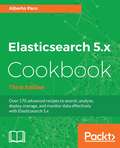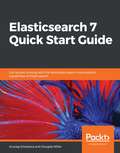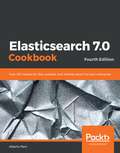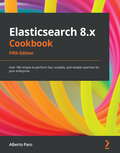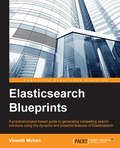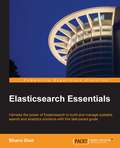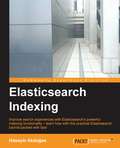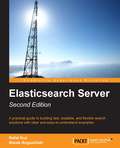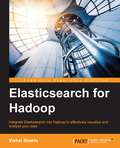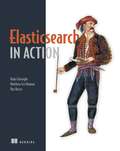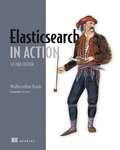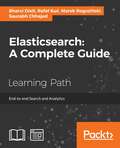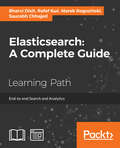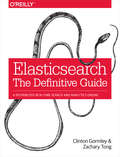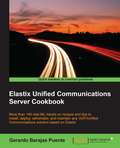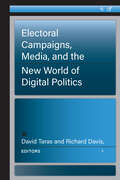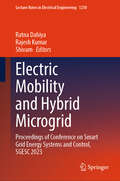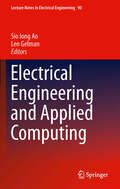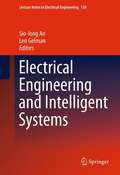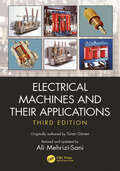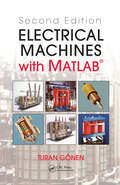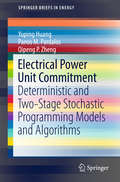- Table View
- List View
Elasticsearch 5.x Cookbook - Third Edition
by Alberto ParoOver 170 advanced recipes to search, analyze, deploy, manage, and monitor data effectively with Elasticsearch 5.x About This Book • Deploy and manage simple Elasticsearch nodes as well as complex cluster topologies • Write native plugins to extend the functionalities of Elasticsearch 5.x to boost your business • Packed with clear, step-by-step recipes to walk you through the capabilities of Elasticsearch 5.x Who This Book Is For If you are a developer who wants to get the most out of Elasticsearch for advanced search and analytics, this is the book for you. Some understanding of JSON is expected. If you want to extend Elasticsearch, understanding of Java and related technologies is also required. What You Will Learn • Choose the best Elasticsearch cloud topology to deploy and power it up with external plugins • Develop tailored mapping to take full control of index steps • Build complex queries through managing indices and documents • Optimize search results through executing analytics aggregations • Monitor the performance of the cluster and nodes • Install Kibana to monitor cluster and extend Kibana for plugins • Integrate Elasticsearch in Java, Scala, Python and Big Data applications In Detail Elasticsearch is a Lucene-based distributed search server that allows users to index and search unstructured content with petabytes of data. This book is your one-stop guide to master the complete Elasticsearch ecosystem. We'll guide you through comprehensive recipes on what's new in Elasticsearch 5.x, showing you how to create complex queries and analytics, and perform index mapping, aggregation, and scripting. Further on, you will explore the modules of Cluster and Node monitoring and see ways to back up and restore a snapshot of an index. You will understand how to install Kibana to monitor a cluster and also to extend Kibana for plugins. Finally, you will also see how you can integrate your Java, Scala, Python, and Big Data applications such as Apache Spark and Pig with Elasticsearch, and add enhanced functionalities with custom plugins. By the end of this book, you will have an in-depth knowledge of the implementation of the Elasticsearch architecture and will be able to manage data efficiently and effectively with Elasticsearch. Style and approach This book follows a problem-solution approach to effectively use and manage Elasticsearch. Each recipe focuses on a particular task at hand, and is explained in a very simple, easy to understand manner.
Elasticsearch 7 Quick Start Guide: Get up and running with the distributed search and analytics capabilities of Elasticsearch
by Anurag Srivastava Douglas MillerGet the most out of Elasticsearch 7's new features to build, deploy, and manage efficient applications Key Features Discover the new features introduced in Elasticsearch 7 Explore techniques for distributed search, indexing, and clustering Gain hands-on knowledge of implementing Elasticsearch for your enterprise Book Description Elasticsearch is one of the most popular tools for distributed search and analytics. This Elasticsearch book highlights the latest features of Elasticsearch 7 and helps you understand how you can use them to build your own search applications with ease. Starting with an introduction to the Elastic Stack, this book will help you quickly get up to speed with using Elasticsearch. You'll learn how to install, configure, manage, secure, and deploy Elasticsearch clusters, as well as how to use your deployment to develop powerful search and analytics solutions. As you progress, you'll also understand how to troubleshoot any issues that you may encounter along the way. Finally, the book will help you explore the inner workings of Elasticsearch and gain insights into queries, analyzers, mappings, and aggregations as you learn to work with search results. By the end of this book, you'll have a basic understanding of how to build and deploy effective search and analytics solutions using Elasticsearch. What you will learn Install Elasticsearch and use it to safely store data and retrieve it when needed Work with a variety of analyzers and filters Discover techniques to improve search results in Elasticsearch Understand how to perform metric and bucket aggregations Implement best practices for moving clusters and applications to production Explore various techniques to secure your Elasticsearch clusters Who this book is for This book is for software developers, engineers, data architects, system administrators, and anyone who wants to get up and running with Elasticsearch 7. No prior experience with Elasticsearch is required.
Elasticsearch 7.0 Cookbook: Over 100 recipes for fast, scalable, and reliable search for your enterprise, 4th Edition
by Alberto ParoSearch, analyze, and manage data effectively with Elasticsearch 7Key FeaturesExtend Elasticsearch functionalities and learn how to deploy on Elastic CloudDeploy and manage simple Elasticsearch nodes as well as complex cluster topologiesExplore the capabilities of Elasticsearch 7 with easy-to-follow recipesBook DescriptionElasticsearch is a Lucene-based distributed search server that allows users to index and search unstructured content with petabytes of data. With this book, you'll be guided through comprehensive recipes on what's new in Elasticsearch 7, and see how to create and run complex queries and analytics.Packed with recipes on performing index mapping, aggregation, and scripting using Elasticsearch, this fourth edition of Elasticsearch Cookbook will get you acquainted with numerous solutions and quick techniques for performing both every day and uncommon tasks such as deploying Elasticsearch nodes, integrating other tools to Elasticsearch, and creating different visualizations. You will install Kibana to monitor a cluster and also extend it using a variety of plugins. Finally, you will integrate your Java, Scala, Python, and big data applications such as Apache Spark and Pig with Elasticsearch, and create efficient data applications powered by enhanced functionalities and custom plugins.By the end of this book, you will have gained in-depth knowledge of implementing Elasticsearch architecture, and you'll be able to manage, search, and store data efficiently and effectively using Elasticsearch.What you will learnCreate an efficient architecture with ElasticsearchOptimize search results by executing analytics aggregationsBuild complex queries by managing indices and documentsMonitor the performance of your cluster and nodesDesign advanced mapping to take full control of index stepsIntegrate Elasticsearch in Java, Scala, Python, and big data applicationsInstall Kibana to monitor clusters and extend it for pluginsWho this book is forIf you’re a software engineer, big data infrastructure engineer, or Elasticsearch developer, you'll find this book useful. This Elasticsearch book will also help data professionals working in the e-commerce and FMCG industry who use Elastic for metrics evaluation and search analytics to get deeper insights for better business decisions. Prior experience with Elasticsearch will help you get the most out of this book.
Elasticsearch 8.x Cookbook: Over 180 recipes to perform fast, scalable, and reliable searches for your enterprise, 5th Edition
by Alberto ParoSearch, analyze, store and manage data effectively with Elasticsearch 8.xKey FeaturesExplore the capabilities of Elasticsearch 8.x with easy-to-follow recipesExtend the Elasticsearch functionalities and learn how to deploy on Elastic CloudDeploy and manage simple Elasticsearch nodes as well as complex cluster topologiesBook DescriptionElasticsearch is a Lucene-based distributed search engine at the heart of the Elastic Stack that allows you to index and search unstructured content with petabytes of data. With this updated fifth edition, you'll cover comprehensive recipes relating to what's new in Elasticsearch 8.x and see how to create and run complex queries and analytics. The recipes will guide you through performing index mapping, aggregation, working with queries, and scripting using Elasticsearch. You'll focus on numerous solutions and quick techniques for performing both common and uncommon tasks such as deploying Elasticsearch nodes, using the ingest module, working with X-Pack, and creating different visualizations. As you advance, you'll learn how to manage various clusters, restore data, and install Kibana to monitor a cluster and extend it using a variety of plugins. Furthermore, you'll understand how to integrate your Java, Scala, Python, and big data applications such as Apache Spark and Pig with Elasticsearch and create efficient data applications powered by enhanced functionalities and custom plugins. By the end of this Elasticsearch cookbook, you'll have gained in-depth knowledge of implementing the Elasticsearch architecture and be able to manage, search, and store data efficiently and effectively using Elasticsearch.What you will learnBecome well-versed with the capabilities of X-PackOptimize search results by executing analytics aggregationsGet to grips with using text and numeric queries as well as relationship and geo queriesInstall Kibana to monitor clusters and extend it for pluginsBuild complex queries by managing indices and documentsMonitor the performance of your cluster and nodesDesign advanced mapping to take full control of index stepsIntegrate Elasticsearch in Java, Scala, Python, and big data applicationsWho this book is forIf you're a software engineer, big data infrastructure engineer, or Elasticsearch developer, you'll find this Elasticsearch book useful. The book will also help data professionals working in e-commerce and FMCG industries who use Elastic for metrics evaluation and search analytics to gain deeper insights and make better business decisions. Prior experience with Elasticsearch will help you get the most out of this book.
Elasticsearch Blueprints
by Vineeth MohanIf you are a data enthusiast and would like to explore and specialize on search technologies based on Elasticsearch, this is the right book for you. A compelling case-to-case mapping of features and implementation of Elasticsearch to solve many real-world use cases makes this book the right choice to start and specialize on Elasticsearch.
Elasticsearch Essentials
by Bharvi DixitHarness the power of ElasticSearch to build and manage scalable search and analytics solutions with this fast-paced guide About This Book * New to ElasticSearch? Here's what you need--a highly practical guide that gives you a quick start with ElasticSearch using easy-to-follow examples; get up and running with ElasticSearch APIs in no time * Get the latest guide on ElasticSearch 2.0.0, which contains concise and adequate information on handling all the issues a developer needs to know while handling data in bulk with search relevancy * Learn to create large-scale ElasticSearch clusters using best practices * Learn from our experts--written by Bharvi Dixit who has extensive experience in working with search servers (especially ElasticSearch) Who This Book Is For Anyone who wants to build efficient search and analytics applications can choose this book. This book is also beneficial for skilled developers, especially ones experienced with Lucene or Solr, who now want to learn Elasticsearch quickly. What You Will Learn * Get to know about advanced Elasticsearch concepts and its REST APIs * Write CRUD operations and other search functionalities using the ElasticSearch Python and Java clients * Dig into wide range of queries and find out how to use them correctly * Design schema and mappings with built-in and custom analyzers * Excel in data modeling concepts and query optimization * Master document relationships and geospatial data * Build analytics using aggregations * Setup and scale Elasticsearch clusters using best practices * Learn to take data backups and secure Elasticsearch clusters In Detail With constantly evolving and growing datasets, organizations have the need to find actionable insights for their business. ElasticSearch, which is the world's most advanced search and analytics engine, brings the ability to make massive amounts of data usable in a matter of milliseconds. It not only gives you the power to build blazing fast search solutions over a massive amount of data, but can also serve as a NoSQL data store. This guide will take you on a tour to become a competent developer quickly with a solid knowledge level and understanding of the ElasticSearch core concepts. Starting from the beginning, this book will cover these core concepts, setting up ElasticSearch and various plugins, working with analyzers, and creating mappings. This book provides complete coverage of working with ElasticSearch using Python and performing CRUD operations and aggregation-based analytics, handling document relationships in the NoSQL world, working with geospatial data, and taking data backups. Finally, we'll show you how to set up and scale ElasticSearch clusters in production environments as well as providing some best practices. Style and approach This is an easy-to-follow guide with practical examples and clear explanations of the concepts. This fast-paced book believes in providing very rich content focusing majorly on practical implementation. This book will provide you with step-by-step practical examples, letting you know about the common errors and solutions along with ample screenshots and code to ensure your success.
Elasticsearch Indexing
by Huseyin AkdoganImprove search experiences with ElasticSearch's powerful indexing functionality - learn how with this practical ElasticSearch tutorial, packed with tips! About This Book * Improve user's search experience with the correct configuration * Deliver relevant search results - fast! * Save time and system resources by creating stable clusters Who This Book Is For If you understand the importance of a great search experience this book will show you exactly how to build one with ElasticSearch, one of the world's leading search servers. What You Will Learn * Learn how ElasticSearch efficiently stores data - and find out how it can reduce costs * Control document metadata with the correct mapping strategies and by configuring indices * Use ElasticSearch analysis and analyzers to incorporate greater intelligence and organization across your documents and data * Find out how an ElasticSearch cluster works - and learn the best way to configure it * Perform high-speed indexing with low system resource cost * Improve query relevance with appropriate mapping, suggest API, and other ElasticSearch functionalities In Detail Beginning with an overview of the way ElasticSearch stores data, you'll begin to extend your knowledge to tackle indexing and mapping, and learn how to configure ElasticSearch to meet your users' needs. You'll then find out how to use analysis and analyzers for greater intelligence in how you organize and pull up search results - to guarantee that every search query is met with the relevant results! You'll explore the anatomy of an ElasticSearch cluster, and learn how to set up configurations that give you optimum availability as well as scalability. Once you've learned how these elements work, you'll find real-world solutions to help you improve indexing performance, as well as tips and guidance on safety so you can back up and restore data. Once you've learned each component outlined throughout, you will be confident that you can help to deliver an improved search experience - exactly what modern users demand and expect. Style and approach This is a comprehensive guide to performing efficient indexing and providing relevant search results using mapping, analyzers, and other ElasticSearch functionalities.
Elasticsearch Server - Third Edition
by Rafal Kuc Marek RogozinskiLeverage Elasticsearch to create a robust, fast, and flexible search solution with ease About This Book * Boost the searching capabilities of your system through synonyms, multilingual data handling, nested objects and parent-child documents * Deep dive into the world of data aggregation and data analysis with ElasticSearch * Explore a wide range of ElasticSearch modules that define the behavior of a cluster Who This Book Is For If you are a competent developer and want to learn about the great and exciting world of ElasticSearch, then this book is for you. No prior knowledge of Java or Apache Lucene is needed. What You Will Learn * Configure, create, and retrieve data from your indices * Use an ElasticSearch query DSL to create a wide range of queries * Discover the highlighting and geographical search features offered by ElasticSearch * Find out how to index data that is not flat or data that has a relationship * Exploit a prospective search to search for queries not documents * Use the aggregations framework to get more from your data and improve your client's search experience * Monitor your cluster state and health using the ElasticSearch API as well as third-party monitoring solutions * Discover how to properly set up ElasticSearch for various use cases In Detail ElasticSearch is a very fast and scalable open source search engine, designed with distribution and cloud in mind, complete with all the goodies that Apache Lucene has to offer. ElasticSearch's schema-free architecture allows developers to index and search unstructured content, making it perfectly suited for both small projects and large big data warehouses, even those with petabytes of unstructured data. This book will guide you through the world of the most commonly used ElasticSearch server functionalities. You'll start off by getting an understanding of the basics of ElasticSearch and its data indexing functionality. Next, you will see the querying capabilities of ElasticSearch, followed by a through explanation of scoring and search relevance. After this, you will explore the aggregation and data analysis capabilities of ElasticSearch and will learn how cluster administration and scaling can be used to boost your application performance. You'll find out how to use the friendly REST APIs and how to tune ElasticSearch to make the most of it. By the end of this book, you will have be able to create amazing search solutions as per your project's specifications. Style and approach This step-by-step guide is full of screenshots and real-world examples to take you on a journey through the wonderful world of full text search provided by ElasticSearch.
Elasticsearch Server: Second Edition
by Rafal Kuc Marek RogozinskiThis book is a detailed, practical, hands-on guide packed with real-life scenarios and examples which will show you how to implement an ElasticSearch search engine on your own websites. If you are a web developer or a user who wants to learn more about ElasticSearch, then this is the book for you. You do not need to know anything about ElastiSeach, Java, or Apache Lucene in order to use this book, though basic knowledge about databases and queries is required.
Elasticsearch for Hadoop
by Vishal ShuklaIntegrate Elasticsearch into Hadoop to effectively visualize and analyze your dataAbout This BookBuild production-ready analytics applications by integrating the Hadoop ecosystem with ElasticsearchLearn complex Elasticsearch queries and develop real-time monitoring Kibana dashboards to visualize your dataUse Elasticsearch and Kibana to search data in Hadoop easily with this comprehensive, step-by-step guideWho This Book Is ForThis book is targeted at Java developers with basic knowledge on Hadoop. No prior Elasticsearch experience is expected.What You Will LearnSet up the Elasticsearch-Hadoop environmentImport HDFS data into Elasticsearch with MapReduce jobsPerform full-text search and aggregations efficiently using ElasticsearchVisualize data and create interactive dashboards using KibanaCheck and detect anomalies in streaming data using Storm and ElasticsearchInject and classify real-time streaming data into ElasticsearchGet production-ready for Elasticsearch-Hadoop based projectsIntegrate with Hadoop eco-system such as Pig, Storm, Hive, and SparkIn DetailThe Hadoop ecosystem is a de-facto standard for processing terra-bytes and peta-bytes of data. Lucene-enabled Elasticsearch is becoming an industry standard for its full-text search and aggregation capabilities. Elasticsearch-Hadoop serves as a perfect tool to bridge the worlds of Elasticsearch and Hadoop ecosystem to get best out of both the worlds. Powered with Kibana, this stack makes it a cakewalk to get surprising insights out of your massive amount of Hadoop ecosystem in a flash.In this book, you'll learn to use Elasticsearch, Kibana and Elasticsearch-Hadoop effectively to analyze and understand your HDFS and streaming data.You begin with an in-depth understanding of the Hadoop, Elasticsearch, Marvel, and Kibana setup. Right after this, you will learn to successfully import Hadoop data into Elasticsearch by writing MapReduce job in a real-world example. This is then followed by a comprehensive look at Elasticsearch essentials, such as full-text search analysis, queries, filters and aggregations; after which you gain an understanding of creating various visualizations and interactive dashboard using Kibana. Classifying your real-world streaming data and identifying trends in it using Storm and Elasticsearch are some of the other topics that we'll cover. You will also gain an insight about key concepts of Elasticsearch and Elasticsearch-hadoop in distributed mode, advanced configurations along with some common configuration presets you may need for your production deployments. You will have "Go production checklist" and high-level view for cluster administration for post-production. Towards the end, you will learn to integrate Elasticsearch with other Hadoop eco-system tools, such as Pig, Hive and Spark.Style and approachA concise yet comprehensive approach has been adopted with real-time examples to help you grasp the concepts easily.
Elasticsearch in Action
by Roy Russo Radu Gheorghe Matthew Lee HinmanSummaryElasticsearch in Action teaches you how to build scalable search applications using Elasticsearch. You'll ramp up fast, with an informative overview and an engaging introductory example. Within the first few chapters, you'll pick up the core concepts you need to implement basic searches and efficient indexing. With the fundamentals well in hand, you'll go on to gain an organized view of how to optimize your design. Perfect for developers and administrators building and managing search-oriented applications.Purchase of the print book includes a free eBook in PDF, Kindle, and ePub formats from Manning Publications.About the TechnologyModern search seems like magic—you type a few words and the search engine appears to know what you want. With the Elasticsearch real-time search and analytics engine, you can give your users this magical experience without having to do complex low-level programming or understand advanced data science algorithms. You just install it, tweak it, and get on with your work.About the BookElasticsearch in Action teaches you how to write applications that deliver professional quality search. As you read, you'll learn to add basic search features to any application, enhance search results with predictive analysis and relevancy ranking, and use saved data from prior searches to give users a custom experience. This practical book focuses on Elasticsearch's REST API via HTTP. Code snippets are written mostly in bash using cURL, so they're easily translatable to other languages.What's InsideWhat is a great search application?Building scalable search solutionsUsing Elasticsearch with any languageConfiguration and tuningAbout the ReaderFor developers and administrators building and managing search-oriented applications.About the AuthorsRadu Gheorghe is a search consultant and software engineer. Matthew Lee Hinman develops highly available, cloud-based systems. Roy Russo is a specialist in predictive analytics.Table of ContentsPART 1 CORE ELASTICSEARCH FUNCTIONALITYIntroducing ElasticsearchDiving into the functionalityIndexing, updating, and deleting dataSearching your dataAnalyzing your dataSearching with relevancyExploring your data with aggregationsRelations among documentsPART 2 ADVANCED ELASTICSEARCH FUNCTIONALITYScaling outImproving performanceAdministering your cluster
Elasticsearch in Action, Second Edition (In Action)
by Madhusudhan KondaBuild powerful, production-ready search applications using the incredible features of Elasticsearch.In Elasticsearch in Action, Second Edition you will discover: Architecture, concepts, and fundamentals of Elasticsearch Installing, configuring, and running Elasticsearch and Kibana Creating an index with custom settings Data types, mapping fundamentals, and templates Fundamentals of text analysis and working with text analyzers Indexing, deleting, and updating documents Indexing data in bulk, and reindexing and aliasing operations Learning search concepts, relevancy scores, and similarity algorithms Elasticsearch in Action, Second Edition teaches you to build scalable search applications using Elasticsearch. This completely new edition explores Elasticsearch fundamentals from the ground up. You&’ll deep dive into design principles, search architectures, and Elasticsearch&’s essential APIs. Every chapter is clearly illustrated with diagrams and hands-on examples. You&’ll even explore real-world use cases for full text search, data visualizations, and machine learning. Plus, its comprehensive nature means you&’ll keep coming back to the book as a handy reference! Foreword by Shay Banon. About the technology Create fully professional-grade search engines with Elasticsearch and Kibana! Rewritten for the latest version of Elasticsearch, this practical book explores Elasticsearch&’s high-level architecture, reveals infrastructure patterns, and walks through the search and analytics capabilities of numerous Elasticsearch APIs. About the book Elasticsearch in Action, Second Edition teaches you how to add modern search features to websites and applications using Elasticsearch 8. In it, you&’ll quickly progress from the basics of installation and configuring clusters, to indexing documents, advanced aggregations, and putting your servers into production. You&’ll especially appreciate the mix of technical detail with techniques for designing great search experiences. What's inside Understanding search architecture Full text and term-level search queries Analytics and aggregations High-level visualizations in Kibana Configure, scale, and tune clusters About the reader For application developers comfortable with scripting and command-line applications. About the author Madhusudhan Konda is a full-stack lead engineer, architect, mentor, and conference speaker. He delivers live online training on Elasticsearch and the Elastic Stack. Table of Contents 1 Overview 2 Getting started 3 Architecture 4 Mapping 5 Working with documents 6 Indexing operations 7 Text analysis 8 Introducing search 9 Term-level search 10 Full-text searches 11 Compound queries 12 Advanced search 13 Aggregations 14 Administration 15 Performance and troubleshooting
Elasticsearch: A Complete Guide
by Rafal Kuc Marek Rogozinski Saurabh Chhajed Bharvi DixitEnd-to-end Search and Analytics About This Book • Solve your data analytics problems with the Elastic Stack • Improve your user search experience with Elasticsearch and develop your own Elasticsearch plugins • Design your index, configure it, and distribute it — you'll also learn how it works Who This Book Is For This course is for anyone who wants to build efficient search and analytics applications. Some development experience is expected. What You Will Learn • Install and configure Elasticsearch, Logstash, and Kibana • Write CRUDE operations and other search functionalities using the Elasticsearch Python and Java Clients • Build analytics using aggregations • Set up and scale Elasticsearch clusters using best practices • Master document relationships and geospatial data • Build your own data pipeline using Elastic Stack • Choose the appropriate amount of shards and replicas for your deployment • Become familiar with the Elasticsearch APIs In Detail Elasticsearch is a modern, fast, distributed, scalable, fault tolerant, open source search and analytics engine. It provides a new level of control over how you can index and search even huge sets of data. This course will take you from the basics of Elasticsearch to using Elasticsearch in the Elastic Stack and in production. You'll start with the very basics: Elasticsearch terminology, installation, and configuring Elasticsearch. After this, you'll take a look at analytics and indexing, search, and querying. You'll learn how to create maps and visualizations. You'll also be briefed on cluster scaling, search and bulk operations, backups, and security. Then you'll be ready to get into Elasticsearch's internal functionalities including caches, Apache Lucene library, and its monitoring capabilities. You'll learn about the practical usage of Elasticsearch configuration parameters and how to use the monitoring API. You'll discover how to improve the user search experience, index distribution, segment statistics, merging, and more. Once you have mastered this, you'll dive into end-to-end visualize-analyze-log techniques with Elastic Stack (also known as the ELK stack). You'll explore Elasticsearch, Logstash, and Kibana and see how to make them work together to build fresh insights and business metrics out of data. You'll be able to use Elasticsearch with other de facto components in order to get the most out of Elasticsearch. By the end of this course, you'll have developed a full-fledged data pipeline. This Learning Path combines some of the best that Packt has to offer in one complete, curated package. It includes content from the following Packt products: • Elasticsearch Essentials • Mastering Elasticsearch, Second Edition • Learning ELK Stack Style and approach This course aims to create a smooth learning path that will teach you how to effectively use Elasticsearch with other de facto components and get the most out of Elasticsearch. Through this comprehensive course, you'll learn the basics of Elasticsearch and progress to using Elasticsearch in the Elastic stack and in production.
Elasticsearch: A Complete Guide
by Bharvi Dixit<P><P>End-to-end Search and Analytics <P><P>About This Book <P><P>Solve your data analytics problems with the Elastic Stack <P><P>Improve your user search experience with Elasticsearch and develop your own Elasticsearch plugins <P><P>Design your index, configure it, and distribute it — you'll also learn how it works <P><P>Who This Book Is For <P><P>This course is for anyone who wants to build efficient search and analytics applications. Some development experience is expected. <P><P>What You Will Learn <P><P>Install and configure Elasticsearch, Logstash, and Kibana <P><P>Write CRUDE operations and other search functionalities using the Elasticsearch Python and Java Clients <P><P>Build analytics using aggregations <P><P>Set up and scale Elasticsearch clusters using best practices <P><P>Master document relationships and geospatial data <P><P>Build your own data pipeline using Elastic Stack <P><P>Choose the appropriate amount of shards and replicas for your deployment <P><P>Become familiar with the Elasticsearch APIs <P><P>In Detail <P><P>Elasticsearch is a modern, fast, distributed, scalable, fault tolerant, open source search and analytics engine. It provides a new level of control over how you can index and search even huge sets of data. This course will take you from the basics of Elasticsearch to using Elasticsearch in the Elastic Stack and in production. <P><P>You'll start with the very basics: Elasticsearch terminology, installation, and configuring Elasticsearch. After this, you'll take a look at analytics and indexing, search, and querying. You'll learn how to create maps and visualizations. You'll also be briefed on cluster scaling, search and bulk operations, backups, and security. <P><P>Then you'll be ready to get into Elasticsearch's internal functionalities including caches, Apache Lucene library, and its monitoring capabilities. You'll learn about the practical usage of Elasticsearch configuration parameters and how to use the monitoring API. You'll discover how to improve the user search experience, index distribution, segment statistics, merging, and more. <P><P>Once you have mastered this, you'll dive into end-to-end visualize-analyze-log techniques with Elastic Stack (also known as the ELK stack). You'll explore Elasticsearch, Logstash, and Kibana and see how to make them work together to build fresh insights and business metrics out of data. You'll be able to use Elasticsearch with other de facto components in order to get the most out of Elasticsearch. By the end of this course, you'll have developed a full-fledged data pipeline. <P><P>This Learning Path combines some of the best that Packt has to offer in one complete, curated package. It includes content from the following Packt products: <P><P>Elasticsearch Essentials <P><P>Mastering Elasticsearch, Second Edition <P><P>Learning ELK Stack <P><P>Style and approach <P><P>This course aims to create a smooth learning path that will teach you how to effectively use Elasticsearch with other de facto components and get the most out of Elasticsearch. Through this comprehensive course, you'll learn the basics of Elasticsearch and progress to using Elasticsearch in the Elastic stack and in production.
Elasticsearch: A Distributed Real-Time Search and Analytics Engine
by Clinton Gormley Zachary TongWhether you need full-text search or real-time analytics of structured data—or both—the Elasticsearch distributed search engine is an ideal way to put your data to work. This practical guide not only shows you how to search, analyze, and explore data with Elasticsearch, but also helps you deal with the complexities of human language, geolocation, and relationships.If you’re a newcomer to both search and distributed systems, you’ll quickly learn how to integrate Elasticsearch into your application. More experienced users will pick up lots of advanced techniques. Throughout the book, you’ll follow a problem-based approach to learn why, when, and how to use Elasticsearch features.Understand how Elasticsearch interprets data in your documentsIndex and query your data to take advantage of search concepts such as relevance and word proximityHandle human language through the effective use of analyzers and queriesSummarize and group data to show overall trends, with aggregations and analyticsUse geo-points and geo-shapes—Elasticsearch’s approaches to geolocationModel your data to take advantage of Elasticsearch’s horizontal scalabilityLearn how to configure and monitor your cluster in production
Elastix Unified Communications Server Cookbook
by Gerardo Barajas PuenteThis book is aimed at those who want to learn how to set up an Elastix Unified Communications Server without losing ground on Unified Communications and Voice over IP.
Election Posters Around the Globe
by Christina Holtz-Bacha Bengt JohanssonThis book examines the history and role of election posters as one of the most crucial forms of political communication, especially in electoral campaigns, in a number of countries around the globe. The contributing authors present comparative research on electoral posters from countries from all five continents, summarizing international similarities and national differences. The book also discusses theoretical aspects and different methodological approaches that are used for studying the design, content and reception of election posters as a means of political communication.
Electoral Campaigns, Media, and the New World of Digital Politics
by Richard Davis David TarasToday, political leaders and candidates for office must campaign in a multimedia world through traditional forums—newspapers, radio, and television—as well as new digital media, particularly social media. Electoral Campaigns, Media, and the New World of Digital Politics chronicles how Twitter, Facebook, Reddit, email, and memes are used successfully and unsuccessfully to influence elections. Each of these platforms have different affordances and reach various audiences in different ways. Campaigns often have to wage different campaigns on each of these mediums. In some instances, they are crucial in altering coverage in the mainstream media. In others, digital media remains underutilized and undeveloped. As has always been the case in politics, outcomes that depend on economic and social conditions often dictate people’s readiness for certain messages. However, the method and content of those messages has changed with great consequences for the health and future of democracy. This book answers several questions: How do candidates/parties reach audiences that are preoccupied, inattentive, amorphous, and bombarded with so many other messages? How do they cope with the speed of media reporting in a continuous news cycle that demands instantaneous responses? How has media fragmentation altered the campaign styles and content of campaign communication, and general campaign discourse? Finally and most critically, what does this mean for how democracies function?
Electric Mobility and Hybrid Microgrid: Proceedings of Conference on Smart Grid Energy Systems and Control, SGESC 2023 (Lecture Notes in Electrical Engineering #1230)
by Rajesh Kumar Ratna Dahiya ShivamThe book contains selected proceedings from the International Conference on Smart Grid Energy Systems and Control (SGESC 2023). It is divided into 2 volumes and focuses on Electric Mobility and Hybrid Microgrid. The topics covered include power electronics for hybrid and electric vehicles, wireless power transfer, renewable power generation, energy storage, and challenges in grid integration of microgrids. This book is a valuable resource for academic researchers and industry practitioners.
Electrical Control and Quantum Chaos with a High-Spin Nucleus in Silicon (Springer Theses)
by Serwan AsaadNuclear spins are highly coherent quantum objects that were featured in early ideas and demonstrations of quantum information processing. In silicon, the high-fidelity coherent control of a single phosphorus (31-P) nuclear spin I=1/2 has demonstrated record-breaking coherence times, entanglement, and weak measurements. In this thesis, we demonstrate the coherent quantum control of a single antimony (123-Sb) donor atom, whose higher nuclear spin I = 7/2 corresponds to eight nuclear spin states. However, rather than conventional nuclear magnetic resonance (NMR), we employ nuclear electric resonance (NER) to drive nuclear spin transitions using localized electric fields produced within a silicon nanoelectronic device. This method exploits an idea first proposed in 1961 but never realized experimentally with a single nucleus, nor in a non-polar crystal such as silicon. We then present a realistic proposal to construct a chaotic driven top from the nuclear spin of 123-Sb. Signatures of chaos are expected to arise for experimentally realizable parameters of the system, allowing the study of the relation between quantum decoherence and classical chaos, and the observation of dynamical tunneling. These results show that high-spin quadrupolar nuclei could be deployed as chaotic models, strain sensors, hybrid spin-mechanical quantum systems, and quantum-computing elements using all-electrical controls.
Electrical Engineering and Applied Computing
by Sio-Iong Ao Len GelmanA large international conference in Electrical Engineering and Applied Computing was just held in London, 30 June - 2 July, 2010. This volume will contain revised and extended research articles written by prominent researchers participating in the conference. Topics covered include Control Engineering, Network Management, Wireless Networks, Biotechnology, Signal Processing, Computational Intelligence, Data Mining, Computational Statistics, Internet Computing, High Performance Computing, and industrial applications. The book will offer the states of arts of tremendous advances in electrical engineering and applied computing and also serve as an excellent reference work for researchers and graduate students working on electrical engineering and applied computing
Electrical Engineering and Intelligent Systems
by Sio-Iong Ao Len GelmanThe revised and extended papers collected in this volume represent the cutting-edge of research at the nexus of electrical engineering and intelligent systems. They were selected from well over 1000 papers submitted to the high-profile international World Congress on Engineering held in London in July 2011. The chapters cover material across the full spectrum of work in the field, including computational intelligence, control engineering, network management, and wireless networks. Readers will also find substantive papers on signal processing, Internet computing, high performance computing, and industrial applications. The Electrical Engineering and Intelligent Systems conference, as part of the 2011 World Congress on Engineering was organized under the auspices of the non-profit International Association of Engineers (IAENG). With more than 30 nations represented on the conference committees alone, the Congress features the best and brightest scientific minds from a multitude of disciplines related to engineering. These peer-reviewed papers demonstrate the huge strides currently being taken in this rapidly developing field and reflect the excitement of those at the frontiers of this research.
Electrical Machines and Their Applications
by Ali Mehrizi-SaniThis popular, easy-to-read book offers a comprehensive yet unique treatment of electrical machines and their historical development. Electrical Machines and Their Applications, Third Edition covers an in-depth analysis of machines augmented with ample examples, which makes it suitable for both those who are new to electric machines and for those who want to deepen their knowledge of electric machines. This book provides a thorough discussion of electrical machines. It starts by reviewing the basics of concepts needed to fully understand the machines, e.g., three-phase circuits and fundamentals of energy conversion, and continues to discuss transformers, induction machines, synchronous machines, dc machines, and other special machines and their dynamics. This natural progression creates a unifying theme and helps the reader appreciate how the same physical laws of energy conversion govern the operation and dynamics of different machine types. The text is sprinkled with ample examples to further solidify the discussed concepts. Several well-placed appendices make the book self-contained and even easier to follow. This book is part of a series on power system topics originally authored by the late Turan Gönen. The book has been edited by Ali Mehrizi-Sani to bring it up to date while maintaining its original charm. Both new and seasoned readers for Gönen’s books will find this new edition a much-awaited update to the second edition.
Electrical Machines with MATLAB
by Turan GonenElectrical Machines with MATLAB encapsulates the invaluable insight and experience that eminent instructor Turan Gonen has acquired in almost 40 years of teaching. With simple, versatile content that separates it from other texts on electrical machines, this book is an ideal self-study tool for advanced students in electrical and other areas of eng
Electrical Power Unit Commitment
by Panos M. Pardalos Qipeng P. Zheng Yuping HuangThis entry into the SpringerBriefs in Energy series offers a systematic review of unit commitment (UC) problems in electrical power generation. This book updates texts written in the late 1990s and early 2000s by including both basics of UC models and state-of-the-art models and solution algorithms, where stochastic models and mixed integer programming techniques are emphasized The UC problems are mostly formulated as mixed integer linear programs, although there are many variants. Some of the varieties of algorithms have been developed for or applied to UC problems include dynamic programming, Lagrangian relaxation, general mixed integer programming algorithms, and Benders decomposition. This book also discusses the recent trends in solving UC problems, especially stochastic programming models, and advanced techniques to handle large numbers of integer decision variables due to scenario propagation.
